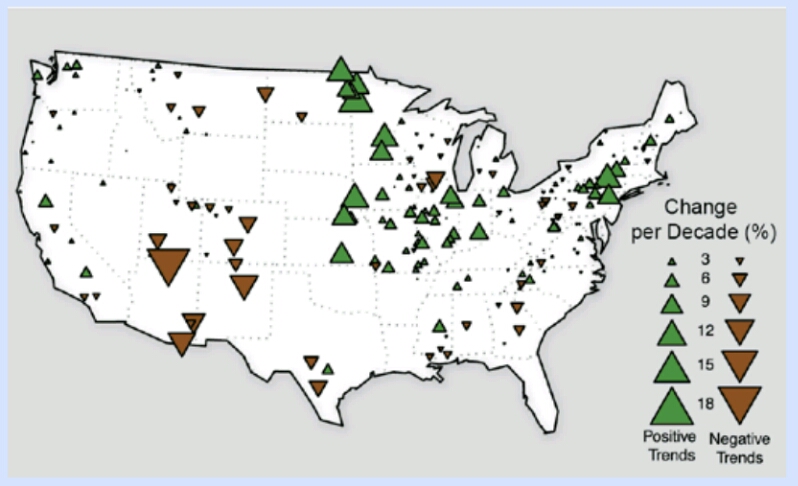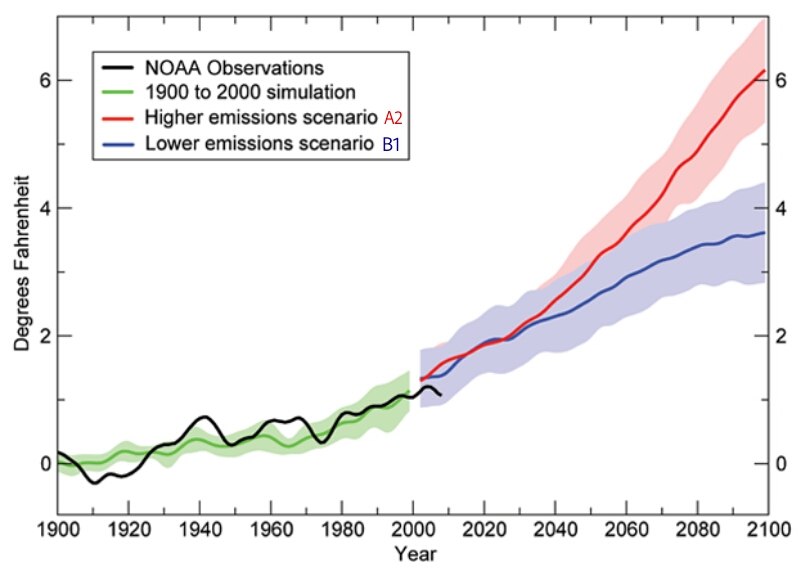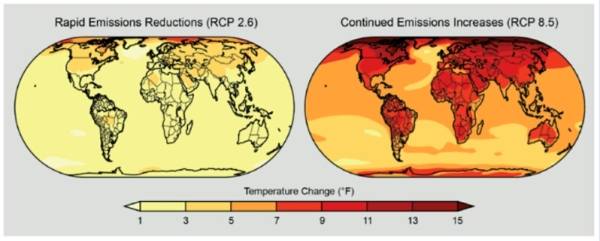What Causes Global Warming?
May 29th, 2015 by Aisha Abdelhamid
Droughts, lengthy hot spells, heavy downpours, floods, and other extreme weather events are occurring more frequently and intensely every year. Around the world, research teams are analyzing these trends, noting the changes in temperature, rainfall, ice mass, sea level, and many other variables recorded by weather measuring devices.
The trends are undeniable: the Earth is getting warmer. Polar sea ice and glaciers are melting, the sea level is rising, and as the oceans absorb more and more carbon dioxide (CO2), they are becoming measurably more acidic. Why is this happening? What is the cause of all this global warming?
Compiled by a team of over 300 experts from the most recent accumulation of data over three years, the 2014 National Climate Assessment (NCA), Climate Change Impacts in the United States, was required by Congress to provide clear answers to these important questions.
The 2014 National Climate Assessment
Overseen by a Federal Advisory Committee of 60 members, the 2014 NCA report is able to help us see what is actually happening to our environment. With a comprehensive federal assessment of global warming, all levels of private and public decision-making can be better informed and equipped for effectively shaping future policy. The assessment clearly outlines what effect global warming is already having on our lives, our livelihoods, and our future.
Interestingly, the 2014 NCA reported that satellite sensors measuring the sun’s output over the past 50 years have recorded no overall increase in the sun’s output. This clearly proves that the sun is not responsible for global warming. Other natural factors, such as volcanoes erupting, were also clearly not the cause. For example, the huge 1991 volcanic eruption of Mount Pinatubo resulted in a short cooling effect. In fact, after separating out natural factors, the 2014 NCA reported that slightly cooler global temperatures might have otherwise been the case, if human activities had not been detrimentally affecting the earth over the past 50 years.
 Image Notes: Separating Human From Natural Influences On Global Warming. The green band shows changes over the last century due to natural forces alone, as simulated by climate models. The blue band shows model simulations of the effects of human and natural forces combined. The black line shows the actual observed global average temperatures. (Source: 2014 NCA, adapted from Huber and Knutti 2012b)
Image Notes: Separating Human From Natural Influences On Global Warming. The green band shows changes over the last century due to natural forces alone, as simulated by climate models. The blue band shows model simulations of the effects of human and natural forces combined. The black line shows the actual observed global average temperatures. (Source: 2014 NCA, adapted from Huber and Knutti 2012b)Human Activities Are the Causes of Global Warming
Mostly consisting of water vapor, the atmosphere is a natural layer blanketing the earth and creating what is known as the “greenhouse effect.” Normally protecting the planet from temperature extremes, when heat-trapping gasses accumulate in the atmosphere this creates an unnatural “expansion” of the greenhouse effect. The result is global warming.
As reported in the 2014 NCA, “Only with the inclusion of human influences can models reproduce the observed temperature changes.” Over approximately the past 100 years, the burning of fossil fuels such as oil, gasoline, and coal has increased the concentration of carbon dioxide in Earth’s atmosphere. CO2 is the chemical result of the burning process which occurs when carbon is introduced into oxygen. To a lesser degree, agricultural practices also contribute to methane emissions, which are far more long-lived in the atmosphere, but are far less abundant than CO2 emissions. Nitrous oxide and Chlorofluorocarbons (CFCs) also contribute in a lesser degree to trapping the heat in Earth’s atmosphere.
The Critical Realities of Global Warming
Negatively impacting every region of the US, Global warming is critically affecting our entire economy. The fast rate at which the earth’s temperature is rising is placing dangerous stress on our society and its infrastructure in ways that US policy is not yet prepared to address. As reported in the 2014 National Climate Assessment, the following facts and figures are outlined to better help us understand the current and critical realities of global warming:
● Primarily human-induced, the global warming of the past 50 years is due to accumulating heat-trapping gases in the atmosphere from the burning of fossil fuels.
● Ocean waters are becoming warmer and more acidic due to absorption of CO2, broadly affecting ocean circulation, chemistry, ecosystems, distribution, and abundance of marine life.
● Earth’s ecosystems, such as forests, barrier beaches, and wetlands, and the biodiversity within them are being impacted, notably in the timing of critical biological events like spring budding, by extreme weather events, and substantial range shifting of many species.
● Longer frost-free periods for plant growth can increase the growth of beneficial plants, as well as ragweed. Some fruit-bearing trees will be impacted by the loss of frost days, as fruit production is often dependent on a tree receiving a specific number of frost days during dormancy.
● Ocean waters are becoming warmer and more acidic due to absorption of CO2, broadly affecting ocean circulation, chemistry, ecosystems, distribution, and abundance of marine life.
● Earth’s ecosystems, such as forests, barrier beaches, and wetlands, and the biodiversity within them are being impacted, notably in the timing of critical biological events like spring budding, by extreme weather events, and substantial range shifting of many species.
● Longer frost-free periods for plant growth can increase the growth of beneficial plants, as well as ragweed. Some fruit-bearing trees will be impacted by the loss of frost days, as fruit production is often dependent on a tree receiving a specific number of frost days during dormancy.
 Image Notes: Observed Increase in Frost-Free Season Length The frost-free season length, defined as the period between the last occurrence of 32°F in the spring and the first occurrence of 32°F in the fall, has increased in each U.S. region during 1991-2012 relative to 1901-1960. (Source: 2014 NCA via NOAA NCDC / CICS-NC)
Image Notes: Observed Increase in Frost-Free Season Length The frost-free season length, defined as the period between the last occurrence of 32°F in the spring and the first occurrence of 32°F in the fall, has increased in each U.S. region during 1991-2012 relative to 1901-1960. (Source: 2014 NCA via NOAA NCDC / CICS-NC)
● Damage to U.S. infrastructure includes roads, buildings, industrial facilities, ports and coastal military installations, rail lines, and airport runways, due to increasing heat, sea level rise, storm surge, and heavy downpours, and is projected to increase with continued climate change.
● Extreme heat, drought, disease, and heavy downpours are causing increasing impacts on crops and livestock, possibly diminishing future food supply security.
● Impacts on ecosystems and livelihoods pertaining to water supply reliability and quality due to heavy flooding are expected to increase.
● Extreme heat, drought, disease, and heavy downpours are causing increasing impacts on crops and livestock, possibly diminishing future food supply security.
● Impacts on ecosystems and livelihoods pertaining to water supply reliability and quality due to heavy flooding are expected to increase.
 Image Notes: Trends in Flood Magnitude. Trend magnitude (triangle size) and direction (green = increasing trend, brown = decreasing trend) of annual flood magnitude from the 1920s through 2008. (Source: 2014 NCA via Peterson et al. 201348)
Image Notes: Trends in Flood Magnitude. Trend magnitude (triangle size) and direction (green = increasing trend, brown = decreasing trend) of annual flood magnitude from the 1920s through 2008. (Source: 2014 NCA via Peterson et al. 201348)
● Increased heat and reduced moisture due to drought conditions are expected to lead to earlier and longer wildfire seasons.
● Fatalities and illness are expected to increase as a result of increasedwildfires, decreased air quality, and diseases transmitted by insects, food, and water.
● Climate change impacts indigenous peoples’ health, well-being, and traditional ways of life, due to loss of ancestral homelands, traditional food supplies, decreased water quality, and increasing exposure to health and safety hazards.
● Rising temperatures and increased extreme weather events are already affecting societies and the environment across the nation. Children, the elderly, the sick, the poor, and nature are especially vulnerable.
● Fatalities and illness are expected to increase as a result of increasedwildfires, decreased air quality, and diseases transmitted by insects, food, and water.
● Climate change impacts indigenous peoples’ health, well-being, and traditional ways of life, due to loss of ancestral homelands, traditional food supplies, decreased water quality, and increasing exposure to health and safety hazards.
● Rising temperatures and increased extreme weather events are already affecting societies and the environment across the nation. Children, the elderly, the sick, the poor, and nature are especially vulnerable.
 Image Notes: Global Warming Observed in US Temperature Rise. Climates vary naturally, so rising temperatures are not distributed evenly across the nation or over time. However, since 1985 the US average temperature has increased by 1.3°F to 1.9°F, and most of the temperature increase has occurred only since 1970. Additionally, the most recent decade was the warmest on US record.
Image Notes: Global Warming Observed in US Temperature Rise. Climates vary naturally, so rising temperatures are not distributed evenly across the nation or over time. However, since 1985 the US average temperature has increased by 1.3°F to 1.9°F, and most of the temperature increase has occurred only since 1970. Additionally, the most recent decade was the warmest on US record.
● The accumulation of heat-trapping gasses already in the atmosphere has committed life on Earth to a hotter future with more climate-related impacts over the next few decades.
 Image Notes: Global Warming Projections for the Future. Different amounts of human-induced, heat-trapping gasses released into the atmosphere produce different projected increases in temperature. A2 assumes continued increases in emissions, and B1 assumes significant emissions reductions. (Source: 2014 NCA via NOAA NCDC / CICS-NC)
Image Notes: Global Warming Projections for the Future. Different amounts of human-induced, heat-trapping gasses released into the atmosphere produce different projected increases in temperature. A2 assumes continued increases in emissions, and B1 assumes significant emissions reductions. (Source: 2014 NCA via NOAA NCDC / CICS-NC)Responding to Global Warming
The primary focus of the 2014 NCA is on identifying the specific and dangerous impacts of global warming in the United States. However, the report also outlines a broad range of steps being studied to reduce the current speed of global warming. Actions to reduce heat-trapping gas emissions, increase carbon uptake, adapt to a changing climate, and increase resilience to climate impacts are all steps in the right direction.
All across society, fossil fuel divestment campaigns are making great strides and seeing great success. Visionary strategies, innovative technologies, and enlightened government policies are leading to more efficient production and increased use of clean, renewable energy sources, such as solar, wind, and geothermal power. Combined with efficient battery storage, all of these clean energy technologies are helping us to correct our course away from deadly fossil fuels.
Between now and the next couple of decades, the choices we make about fossil fuel emissions will have a significant impact on global warming. It is the future of all life on Earth, not just the human race, that is at stake. But it is only the human race that is responsible for the mess we’ve made of the planet, and we are the ones who must now work together to fix it.
 Image Notes: Projected Change in Average Annual Temperature Over the Period 2071-2099 (compared to the period 1970-1999). A low scenario assumes rapid reductions in emissions and concentrations of heat-trapping gases (RCP 2.6), and a higher scenario assumes continued increases in emissions (RCP 8.5). (Source: 2014 NCA via NOAA NCDC / CICS-NC)
Image Notes: Projected Change in Average Annual Temperature Over the Period 2071-2099 (compared to the period 1970-1999). A low scenario assumes rapid reductions in emissions and concentrations of heat-trapping gases (RCP 2.6), and a higher scenario assumes continued increases in emissions (RCP 8.5). (Source: 2014 NCA via NOAA NCDC / CICS-NC)
Keep up to date with all the most interesting green news on the planet by subscribing to our (free) Planetsave newsletter.
Comments